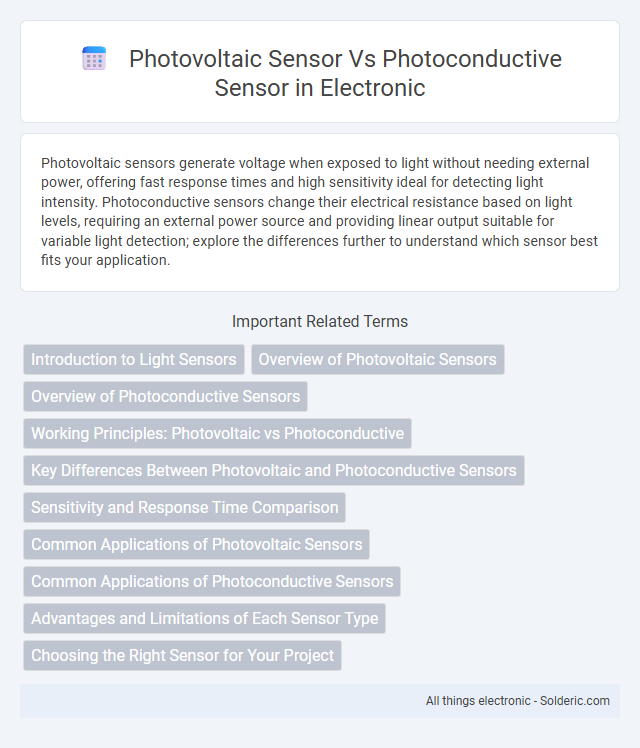Photovoltaic sensors generate voltage when exposed to light without needing external power, offering fast response times and high sensitivity ideal for detecting light intensity. Photoconductive sensors change their electrical resistance based on light levels, requiring an external power source and providing linear output suitable for variable light detection; explore the differences further to understand which sensor best fits your application.
Comparison Table
| Feature | Photovoltaic Sensor | Photoconductive Sensor |
|---|---|---|
| Working Principle | Generates voltage when exposed to light (solar effect) | Changes electrical resistance with light intensity |
| Output Signal | Voltage generated without external power | Change in current under constant voltage |
| Response Time | Slower response | Faster response |
| Sensitivity | Generally lower sensitivity | Higher sensitivity to light changes |
| Power Requirement | Self-powered, no external power needed | Requires external bias voltage |
| Common Materials | Silicon, semiconductor junctions | Cadmium sulfide (CdS), cadmium selenide (CdSe) |
| Typical Applications | Solar cells, optical power measurement | Light meters, camera exposure controls |
| Temperature Sensitivity | Lower temperature effect on output | Higher temperature dependence |
| Durability | More durable with no external bias | Less durable due to bias and thermal effects |
Introduction to Light Sensors
Photovoltaic sensors generate voltage directly from light exposure using the photovoltaic effect, making them highly efficient for energy harvesting and low-light detection applications. Photoconductive sensors alter their electrical resistance in response to light intensity, allowing precise measurement of varying light levels in optical devices and safety systems. Your choice depends on whether you need direct voltage output with fast response (photovoltaic) or sensitive resistance changes for light intensity monitoring (photoconductive).
Overview of Photovoltaic Sensors
Photovoltaic sensors generate electrical voltage directly from incident light without requiring an external power source, relying on the photovoltaic effect commonly seen in semiconductor materials like silicon. These sensors offer high sensitivity, fast response times, and are widely used in solar energy applications, light measurement, and optical detectors. Unlike photoconductive sensors that change resistance with light intensity, photovoltaic sensors produce a voltage proportional to the light intensity, enabling precise and energy-efficient light detection.
Overview of Photoconductive Sensors
Photoconductive sensors operate by changing their electrical resistance when exposed to light, utilizing materials such as cadmium sulfide (CdS) or cadmium selenide (CdSe). These sensors are widely used for detecting light intensity in applications like night lights, street lamps, and light meters due to their sensitivity and relatively simple construction. Unlike photovoltaic sensors that generate voltage directly from light, photoconductive sensors require an external power source to measure the variation in resistance caused by light exposure.
Working Principles: Photovoltaic vs Photoconductive
Photovoltaic sensors generate voltage when exposed to light by converting photons directly into electrical energy using the photovoltaic effect, enabling self-powered operation without external bias. Photoconductive sensors rely on changes in electrical resistance caused by light-induced excitation of charge carriers within a semiconductor material, requiring an external voltage supply for operation. The fundamental difference lies in photovoltaic sensors producing an electromotive force upon illumination, whereas photoconductive sensors modulate conductivity under light exposure.
Key Differences Between Photovoltaic and Photoconductive Sensors
Photovoltaic sensors generate voltage directly through the photovoltaic effect without requiring external bias, making them ideal for low-light and energy-efficient applications. Photoconductive sensors change their electrical resistance in response to light intensity, necessitating external bias and offering faster response times with enhanced sensitivity. Key differences include their operating mechanism, power requirements, and suitability for specific sensing environments.
Sensitivity and Response Time Comparison
Photovoltaic sensors typically offer higher sensitivity due to their ability to generate voltage directly from incident light without external power, making them ideal for detecting low light levels. Photoconductive sensors respond faster because their resistance changes almost instantaneously when exposed to light, enabling quicker detection of light variations. Your choice depends on whether sensitivity or response time is the priority in your specific application.
Common Applications of Photovoltaic Sensors
Photovoltaic sensors are commonly used in solar energy harvesting, providing efficient conversion of light into electrical energy for solar panels and outdoor lighting systems. They are also integral in light metering devices and remote sensing applications due to their self-powered operation and high sensitivity to light intensity. These sensors are preferred in environments requiring low power consumption and reliable light detection without the need for external power sources.
Common Applications of Photoconductive Sensors
Photoconductive sensors are commonly used in optical communication systems, smoke detectors, and light meters due to their fast response time and sensitivity to varying light intensities. Their ability to change resistance based on light exposure makes them ideal for automatic lighting controls and alarm systems. Your choice of sensor depends on the specific application requirements, where photoconductive sensors excel in detecting rapid changes in light conditions.
Advantages and Limitations of Each Sensor Type
Photovoltaic sensors generate voltage directly from light without an external power source, offering high sensitivity and low noise, while their limitation lies in slower response times and lower output current compared to photoconductive sensors. Photoconductive sensors change their resistance under illumination, providing faster response and higher signal levels but requiring external bias voltage, which can increase noise and power consumption. Selecting between these sensors depends on application requirements like sensitivity, speed, power availability, and signal integrity.
Choosing the Right Sensor for Your Project
Photovoltaic sensors generate voltage when exposed to light, making them ideal for low-power applications requiring direct electrical output without external power sources, while photoconductive sensors change their resistance under illumination, suited for circuits needing variable resistance-based detection. Selecting the right sensor depends on project requirements such as power availability, response time, and sensitivity; photovoltaic sensors offer faster response and no external bias, whereas photoconductive sensors provide adjustable sensitivity through biasing but may consume more power. Understanding these operational characteristics ensures optimal sensor performance in applications like light meters, solar energy harvesting, or optical switch controls.
photovoltaic sensor vs photoconductive sensor Infographic

 solderic.com
solderic.com